Porcelain Insulator News
by Jack H. Tod
Reprinted from "INSULATORS - Crown Jewels of the Wire", May 1973, page 4
Preferably direct porcelain news items and questions directly to Jack H. Tod,
3427 N. 47th Place, Phoenix, Ariz. 85018. Reply stamp is appreciated. All mail
will be answered, and the most newsworthy items and questions of general
interest will be published as space permits.
RESEARCH TRIP
I will be away on a 7-week porcelain insulator research trip from late March
until mid-May. This trip will be to all the eastern porcelain areas, and the
itinerary includes visits to over 20 active porcelain insulator factories and
the sites or locales of over 30 defunct porcelain plants. It is anticipated that
considerable information will be added to the files on the histories of
porcelain companies and on attributing many specific insulators and markings
that we still know little about.
It is hoped you will all bear with us in the
lack of current news items in the column for an issue or two and also that you
will excuse delays in answers to some of the questions by mail during this
period.
Tony Petrarca (Cleveland) has a threadless reported for the first time, and
we've just completed the drawing of it by remote control as shown here. Tony
says that it is "dull white, like the top of an old cider gallon jug."
This is the first one of these I've heard of, and we now have a new goody to
keep our eyes out for. I think everyone will agree that this item takes the
prize for the hottest news item of the month, and Tony can take one giant step
to the front.
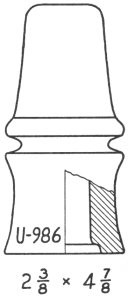
This new threadless is tentatively assigned U-986 in the Universal
Style Chart. We would like to hear from anyone else who locates another specimen
of this.
Jack
Dear Mr. Tod:
Just a note to say that I certainly enjoy your "Porcelain Insulator
News" column. I noted on page 9 of the December Crown Jewels your comments
regarding the G. P. Co. markings. I have a mint, white U-282B with the
trademark style of marking on the crown about midway between the wire groove and
the top. Just thought you might like to know.

Another item of interest is an old unmarked transposition, mint, brown,
U-192. On top is an incuse "3" which is about 3/8" tall. Since
this is a one-piece item, does the number perhaps refer to a specific use? I
don't have any good ideas.

And finally, I have a mottled brownish-grey strain insulator 4 1/2" x 4
1/2". Embossed (raised characters) on one side of the "rib" is
PATENTED SEPT. 22, 1914. On the opposite side of the insulator on another
"rib" is the embossed Westinghouse trademark.

Any information on this
one?
Sincerely,
Fred Gifford
Box 199,
Hyde Park, Utah W18
Dear Fred:
Yes, we are all glad to know about your U-982B with confirmation of that G.
P. Co. marking, and I'll personally be glad to know when you get a dupe to trade
me!
There is no way of telling what the numeral stamped on your U-192 means. Such
numerals and letters are very common on all porcelain insulators and are just
forms of factory control markings as with mold numbers on glass insulators. On
porcelain these characters designate such things an customer order number,
special groove widths, special glazes, manufacturing year or quarter, trimmer
operator code, etc. I choose to just ignore 'em.
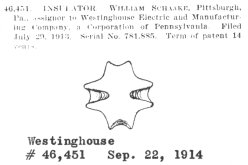

The patent date on your Whse guy strain is for the design patent #46,451
shown above. Your specimen is a dry press unit, but they also handstamped the
wet process ones with this patent date. There must have been a jillion of these
as I keep answering this question very regularly. Maybe this answer will stem
the tide.
This patent was for the 8-fluted design, and its term expired in 1928. Thus,
other companies have made similar 8- fluted strains since then (and still do
now).
Regular letters patents cover items which involve invention
(something new or better than any prior invention). Design patents cover
specific designs of items which are not novel in themselves and for which a
letters patent could not be obtained, and they can be obtained in routine
fashion.
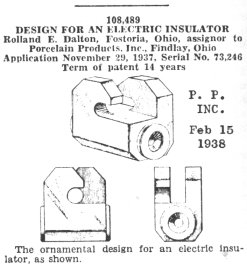
Another example of this is the design patent shown at right for the
P.P. self-tying knob. The principle involved was not novel and therefore
unpatent able, but the particular design was protected for 14 years with the
design patent. When tracking down patents on porcelain insulators in the
Gazette, always check the design patents if the number is a low one (less than
150,000 or so). Also if you don't find the insulator in the
"inventions" listing in the index, check the list of
"designs" and it may be there.
Jack
Dear Jack:
Another interesting porcelain presented itself to us for 25 cents at a bottle show yesterday. It is a crude, pitted, dirty white,
standard porcelain No. 1 knob incuse marked "WIRT NO. 1" around the
bottom rim. Any info yet on this marking?
Jarl & Karen Anderson
New Bedford,
Mass.

Answer: Well, maybe yes, maybe no. A Herbert C. Wirt was granted a patent
June 28, 1892 (assigned to Thomson-Houston Electric Co.) on a wiring knob
somewhat similar in principle to the "fireplug" type. Since the
standard porcelain part of the Code wasn't published until 1897, maybe your knob
marking indicates T-H first popularized this shape and that it was a H. C. Wirt
design. Just a wild guess.
Jack
Dear Jack:
Here's a "dated control" for you to add to your list.

I have a
U-672 with an incuse "NOV 30 ANS'D" on the skirt. I didn't know what
it was 'til I got your new Supplement. So again my thanks.
Larry E. Thomas
(Oroville, Cal.)
Dear Larry:
Great! We now have PAID, ENT'D, REC'D, P.M. and your ANS'D. All we lack now
is the A.M., and then we can all rise and yell "Bingo!" All the
specimens carrying these markings that I have seen to date have been
manufactured by Pittsburg High Voltage. I am reasonably certain now that the
marking was used to date production runs and that the dating stamp
"word" was used in place of the years as a factory code, much the same
as Pinco and others did in later years in their markings.
Jack
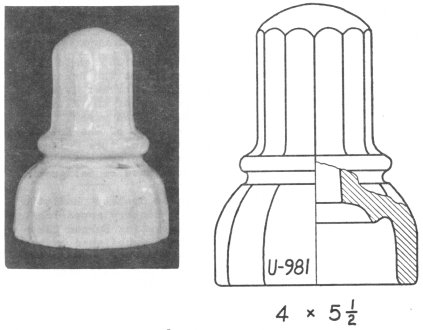
Dear Jack:
Am enclosing a photo of a threadless "gem" which I've written
several about but no one seems to have seen this one before.... I picked it up
in an antique store in eastern Canada but owner had no idea of background on it.
Any info you might have or to whom I might write would be appreciated.
G. L.
"Spud" Crozier
(Edmundson, N.B., Canada)
Box 211, Madawaska, Maine 04756
Dear "Spud":
Many thanks for the first report of this jewel here and for the subsequent
letter so we could make the above drawing by shadow profile and measured dims
(remote control).
This item was previously reported by Gerald Brown in his Second Edition, but
you still have a real winner here. I have tentatively assigned the number U-981
to this one. This 14-ribbed threadless is another one of the Elliot designs of
early threadless "flint" insulators, and please refer to Jerry
Turner's letter following -- which is also new information on these insulators.
Jack
Dear Jack:
John Morgan (New Hampshire) showed me a woodcut dated 1853 (photocopy
enclosed) which clearly shows 3 Elliot-type insulators in a display of Bennington
ware. The picture shown on page 15 of "Bennington Pottery &
Porcelain" by Richard Carter Barret printed by Bonanza Books of N.Y. I
thought you would be interested in the date and origin of the manufacturer.
Jerry Turner
Goshen, Ohio
Dear Jerry:
Yes, this clearly carries us from the 1858 date back another 5 years to 1853,
and also confirms the Bennington connection without doubt. As you know, Forrest
Jones (Ohio) is the owner of a unique specimen of the Elliot type (U-982)
threadless made of "Bennington ware".
The 1853 date is of interest in light of the following quotation from page 11
of "Porcelain Insulators Guide Book for Collectors": "... there
are some references to 'flint' or 'porcelain' insulators having been used on
telegraph lines as early as about 1853."
My reference: The American Ceramic Society "Bulletin", 1939, Vol.
18, page 407, and quoting history appearing in the valuable and informing book,
"Marketing Burned Clay Products", by A, Hamilton Chute, Ph.D.,
published by the Bureau of Business Research, Ohio State Univ., June 1939:
"Electrical porcelain has been mentioned since about the middle of the
Nineteenth Century. The exhibits at the Crystal Palace in New York in 1853
included 'telegraph insulators of white flint', which were employed on the
telegraphs in the vicinity of Boston. Two potteries in different eastern states
contended for the honor of having made the first telegraph cups for Morse during
his early experiments (1830-1842)."
We'd better watch out here. We certainly would not want to continue this
research to the point of taking away the glory of the boys with the glass block
insulators! Also of interest (but off the subject), and in connection with other early threadless porcelains located in the south in 1969 is an
additional quotation (same source):
"A pottery in Kaolin, S.C. during the
War, made porcelain and pottery insulators for use on the Confederate telegraph
lines."
Maybe while I do my brand of digging in the various library stacks some of
you other insulator buffs should try out the dump digging in Kaolin. Wow, just
the thought of finding that one!
Jack
Edna Comstock (Solano Beach, Cal.) has the knack of coming upon some of the
best early classics, and here are two that she has now, drawings made from her
specimens. The one which is tentatively U-944 here (unmarked) is the Thomas 5
"M" cataloged in 1904. This white specimen is a real
"jewel".
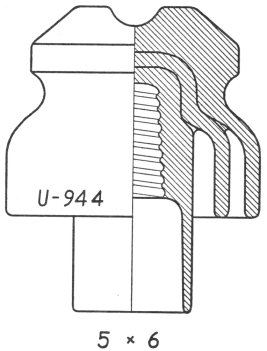
Any of these early Thomas glaze-filled specimens are truly museum pieces.
Edna's specimen at the left has the Imperial Porcelain Works marking and is
tentatively U-924 in the porcelain style chart. This one in a wet process one
similar to the U-925. I estimate manufacturing date of about 1897, and it is
also a nice early classic.
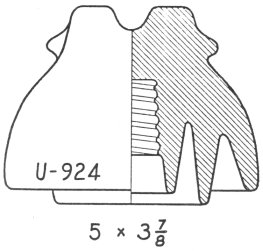
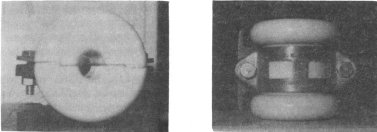

Dear Jack:
I found this insulator about 2 months ago. I
have searched & searched around at shows & books but
have yet to find this insulator listed. It is marked as shown (above right).
Could you give me some information on a price value and rarity of this piece?
Richard F. Girard
2034 Herbert Dr., Waukeegan,Ill. 60085
Dear Richard:
This insulator is covered by the patent shown at right, and sorry about the
fuzzy print job here. There are many such clamp-type insulator designs all the
way up to the current ones, and the ones most commonly known in collector
circles are those of Louis Fort (of Jersey City) and John R. Fletcher (Dayton,
Ohio).
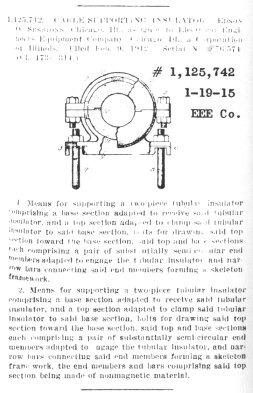
The company involved on this one is Electrical Engineers Equipment Co.,
Chicago, Ill. Founded in 1910 and manufactured high-tension and substation
equipment of all kinds.
No, I can't help you with a trade value on this item. It's hard to determine
how many of the collectors are interested in the many types of insulators other
than pin types. Many of the oddballs could sit on a sales table forever with a
$1 sticker and attract no interest. However, yours has a company marking, a
patent date, a determinable use, true antiquity and remarkably nice condition.
My wild guess is $20, and someone collecting clamp types might pay that. It
probably wouldn't attract others at even $5 value.
Dear Jack:
I enjoy reading your Porcelain Corner in "Insulators Crown Jewels of the
Wire".
(1) I would like info about the little insulator as drawn here. It may be
"old hat" to you but I have never seen any articles including this
one. The underglaze (green ink) marking is smaller than I've shown. I found this
in an old mine dump last summer in Leadville, Colorado. Could it be Union
Porcelain Works?
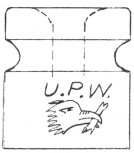
(2) 1 have a Hewlett type, crudely made, unmarked, 8" diameter, 3"
thick, brown. It has straight sides, not curved in like all others. Any info
about this one and to age, etc.?
Ernie Spurling
490 Sterling St.
Sedro Valley,
Wash 98284
Dear Ernie:
(1) See Fisher's bushing on page 15, February, issue. Now we're getting
somewhere! In the 1860-1865 period, the customary cut that went with
"Union" was either an eagle, a cannon or clasped hands. I'll now put
my betting money on Union Porcelain Works, established 1865 in Brooklyn, N.Y.
(and now of Trenton, N.J.). They started making dry press electrical porcelain
in about 1879 and are still in business. By the time you read this issue, I
should have the word direct from the horse's mouth.
(2) You may have a museum piece with that old Hewlett (strain) insulator.
Just as the first few O-B link strain insulators (pork livers) made in 1909 had
a straight side instead of the ball edge, this could have been one of the first
Hewletts. There are several of the early straight-side O-B link strains known in
collections. Your Hewlett could be rare too. The customary Hewlett strain with
the curved in side has what is termed a "fish tail" edge because of
the shape of the cross section. Maybe we should call yours the "brook
trout" (Ole Square Tail) Hewlett. 
Jack
Harold Anglin (Fontana, Cal.) has an early Thomas 2-piece multipart porcelain
with the incuse markings shown here.

Since Thomas was as consistent as warts on
a frog with their sameness logotype marking (sans-serif Gothic) for all their
years of pin type manufacture, that solitary S with the serifs in this marking
is a real eye opener. This will remain the winner until someone finds a
"THOMAS" logotype!
There are a goodly number of patented "self-tying" and
"adjustable" knob and cleat designs, some patented as early as the
1880's. I not only am an avid collector of these things, but we want to publish
an article on them in a fall issue. I would appreciate hearing from anyone who
has any of these, and donated specimens are always welcome (Hal).
The sketches below are of representative ones. My art isn't so hot but should
improve if I continue to collect these things. These are: (1) Knox #31 tieless
knob; (2) Patent #483,771, Pass & Seymour, 1892, self-tying knob; (3)
Hammond self-tying cleat, Pat. 3-1-92; (4) Pass & Seymour 1892 adjustable
single cleat.
Thanks,
Jack H. Tod
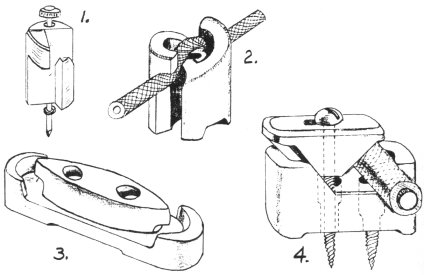
Refer to the wide-ear helmet shown on page 8, Dec. 1972 issue. Joanne Kelsey
(Fairport, N.Y.) also has one of these and also from New Hampshire. It has a
THOMAS marking, a faint one on the skirt, so that settles that. This shape is
tentatively U-389 in the style chart.
| 